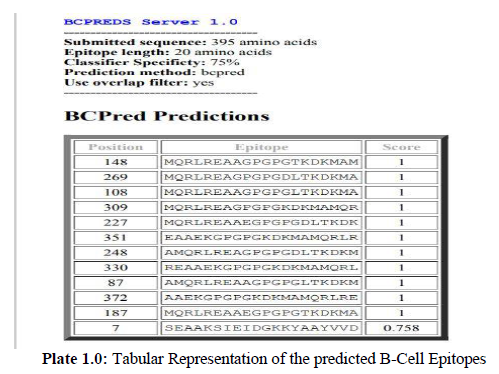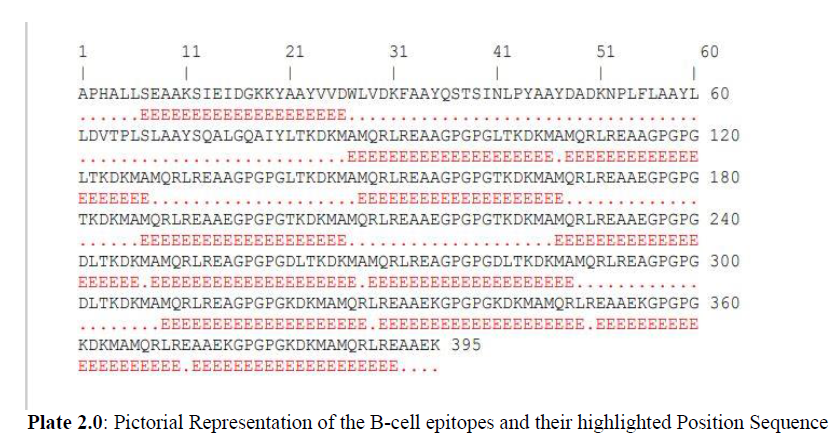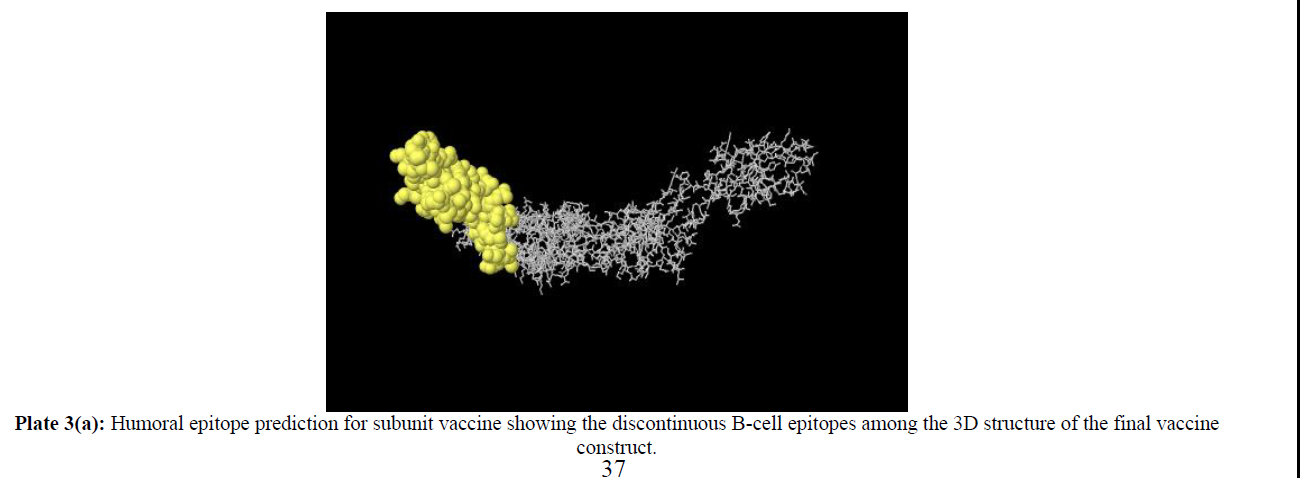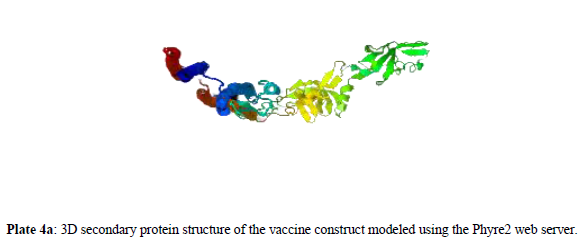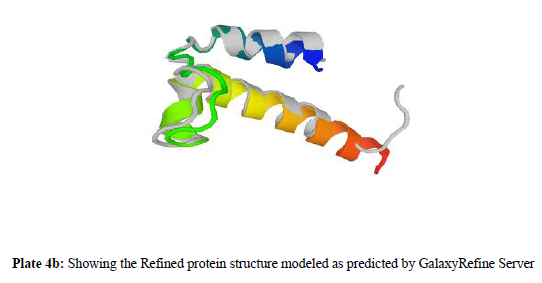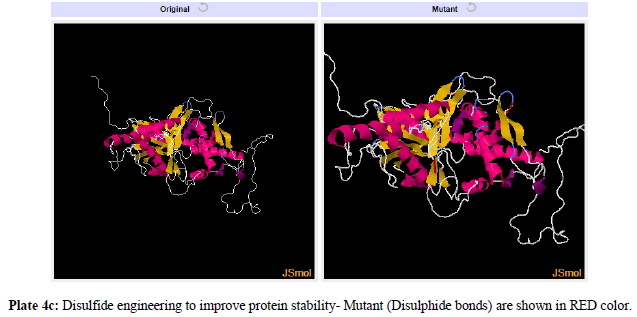Research - Der Pharma Chemica ( 2021) Volume 13, Issue 6
Exploring the Potentials of Campylobacter spp. Chaperone Proteins in the Design of B and T Cell Multi-Epitope Subunit Vaccine: An Immunoinformatics approach
Kaka MO1*, Adeosun IJ1, Olotu TM1, Oyebamiji AK2,3, Ajayeoba TA1 and Oyawoye OM12Department of Basic Sciences, Adeleke University, P.M.B 250, Ede, Osun State, Nigeria
3Computational Chemistry Research Laboratory, Department of Pure and Applied Chemistry, Ladoke Akintola University of Technology, Ogbomoso, Oyo State, Nigeria
Kaka MO, Department of Microbiology, Laboratory of Molecular Biology, Immunology and Bioinformatics, Adeleke University, P.M.B 250, Ede, Osun State, Nigeria, Email: kakaoluwatosin@gmail.com
Received: 07-Feb-2021 Accepted Date: Jun 23, 2021 ; Published: 30-Jun-2021
Abstract
Campylobacter has been reported to be the cause of community-acquired infection and is often presented in immunocompromised individuals as acute gastrointestinal illness. It is also often transmitted through undercooked poultry products. Campylobacter also causes significant morbidity, leading to huge cases of disability but limited mortality (there can be about 75,000 annual fatal cases). Heat shock proteins are defined as a group of highly conserved and regulated proteins which are known to play vital roles in enabling diverse organisms cope with physiological stress. Thus, this study used an immunoinformatic approach to design a multi-epitope based vaccine that is targeted against Campylobacter spp. and related infections using Heat shock protein sequences. Designed subunit vaccine was evaluated for its antigenicity, immunogenicity, allergenicity and physicochemical parameters. A total of 7200 CTL epitopes (9-mer) were predicted using Net CTL 1.2 server, among them only 97 epitopes with high ranked binding affinity score were chosen as final CTL epitopes. Similarly, the HTL epitopes were identified using IEDB MHC-II prediction module based on the higher binding affinity with MHC- II, the mouse alleles used for the prediction were HLA-DRB1*01:01, HLA-DRB1*01:02, HLA-DRB1* 01:03, HLA-DRB1*01:04. A maximum immune response TLR-5 agonist (Accession number: P04949) was used as an adjuvant and CTL epitopes were combined together by EAAAK linker, intra-CTL and intra-HTL epitopes joint by AAY and GPGPG linker to make a final vaccine construct of 1723 amino acid residues designed using 97 CTL and 3 HTL epitopes Collectively, this research provides novel candidates for epitope-based peptide vaccine design against Campylobacter spp.
Keywords
Campylobacter spp., Chaperone proteins, Vaccine, Immunoinformatics
Introduction
Campylobacter has been reported to be the vital cause of gastrointestinal bacterial pathogen in human beings [1]. C. jejuni is responsible for approximately 90% of infective cases while C. coli is responsible for the remaining 10%. Other species responsible for human campylobacteriosis are however, more rarely involved. Campylobacteriosis is generally a self-limited disease inducing symptoms such as abdominal pain, diarrhea and fever, but it can also lead to gastrointestinal manifestations such as bacteremia and neurological disorders [2]. Human infections by Campylobacter are majorly caused by handling and/or the consumption of raw or undercooked poultry meat. Birds are the main reservoir of the pathogen as they carry it in a commensal relationship within their intestines. There have been alarming issues regarding antibiotic resistance in Campylobacter spp., as well as the decreasing effectiveness of commonly used antibacterials against the pathogen [3]. In order to address this problem, a multifaceted approach is needed to combat the prevalence and these include improvements in sanitation, availability of safe water, food safety and security, increased breast-feeding, adequate nutrition, and required vaccination [4].
Despite studies by scientists over the years, the conventional method of vaccine production against Campylobacter in poultry has not led to the development of vaccine in terms of immunogenicity. It is important to intensify efforts to test and validate new vaccine antigens, hence, reverse vaccinology is a suitable strategy to this end [5].
PEB1 and flagellin- two major Campylobacter antigens, have been evaluated as vaccine candidates. However, there are varying levels of glycosylation and high antigenic diversity in Campylobacter, making the development of a flagellin-based vaccine difficult [6]. Also, in a recent study, it was observed that significant levels of anti-PEB serum IgG was unable to serve as protection against C. jejuni after an oral challenge in mice [7]. Despite the fact that the full elucidation of the molecular basis of pathogenicity of Campylobacter has not been done, through the use of in vivo and in vitro studies, various virulence factors have been identified. Examples are: flaA, cadF, CsrA (which function in adhesion; iam, virB11, ciaB and pldA (which function in invasion); CDT (CdtA, CdtB and CdtC)( which function in cytotoxicity) and dnaJ (which function as heat shock protein). These Heat-shock proteins (HSPs) function importantly in thermotolerance [8]. They also function effectively in response to diverse stresses by acting as chaperones (promoting the folding of cellular proteins) and in the proteolysis of deleterious, misfolded proteins. Furthermore, various HSPs have also been identified in C. jejuni, and they include the GroESL, DnaJ, DnaK and ClpB proteins [9].
The synthesis of Heat Shock Proteins (HSPs) occurs virtually in all cells under stress conditions, (i.e temperature or nutrient change). Cells known to react to these chemical and physiological changes include Prokaryotic and Eukarvotic ones and this is caused by the induction of stress or HSPs[10]. Scientific research has shown that these proteins play vital roles as molecular in-vivo chaperones. They also act as immune-dominant antigens during cases of infections by bacteria. Highly immunogenic recombinant Heat shock proteins which include Salmonella Typhi rHsp60 [11], Histoplasma capsulatum rHsp60 [12] and Paracoccidioides brasiliensis rHsp60 [13] have the ability to induce protective immunity against deleterious challenges posed by homologous pathogens.
The most conserved proteins and the best characterized HSPs are those belonging to the 60-kDa (GroEL) and 70-kDa (DnaK) families. In addition, HSPs of bacterial organisms have piqued the interests of researchers, especially microbiologists for various years, as they constitute the major targets of the immune response of hosts (Kaufmann and Schoel, 1994). DnaK homologues of diverse bacterial pathogens have been observed to be immunogenic in humans/animals It has also been shown by an experiment involving the infection of mice with Borrelia burgdorferi, that protection against microbial infections may occur as a result of immunization with proteins containing DnaK-specific sequences.
Subunit vaccines are produced from parts of the microorganisms and are known to be safe and effective for human and animals. These vaccines are also capable of inducing humoral- and cell-mediated immunities against microbial antigens. Thus, in order to develop effective subunit vaccines, the identification and prediction of the antigenic epitopes by bioinformatics tools is imperative [14,15]. Furthermore, the application of Bioinformatics methods help provide new theoretical approaches for vaccine design based on immunological databases including but not limited to Epitope form, MHC alleles, molecular interactions, docking pathogens and host cells [16].
Although studies on the evolution of the outer membrane proteins of C. jejuni as vaccine candidates have been carried out (Meunier et al., 2017), heat shock proteins can be considered for protective vaccine design independentl. Thus, this research was aimed at analyzing heat shock proteins for the epitope-based peptide candidate’s identification and evaluation of its proteomic database using In silico tools for a new vaccine candidate development.
Alternative therapies remain an urgent need for patients, hence, the need for vaccine development (Bianconi et al., 2019). Hence, further to the above, this study is aimed at exploring the potentials of Campylobacter species heat shock proteins in designing a multi-epitope subunit vaccine using the immunoinformatics approach.
Methodology
Retrieval of Campylobacter spp. protein sequence and antigenic conduct assurance
A total of 58 Essential/Chaperonin proteins (DnaJ, DnaK, GrpE, groL, groS, HtpG, Lon Protease) of Campylobacter spp. were obtained from the National Center for Biotechnology Information (NCBI) protein database (Retrieval date April, 2020) and subjected to multi-epitope vaccine designing. The induction of a significant immunogenic response in host system is the major purpose of vaccination, thus, all protein sequences that had been retrieved were subjected to ANTIGEN pro web server in order to predict their antigenicity. Based on the antigenicity result, only 19 proteins were found to havean antigenic probability of ≥0.8 were selected and used in the next step.
Prediction of CTL & HTL Epitopes
The retrieved antigenic protein sequences were subjected to Net CTL and IEDB server to predict CTL and HTL epitopes respectively. In observing the binding predictions of MHCII, the web-based IEDB analysis resource was used as a Consensus tool. High comb scores, length, and immunogenicity scores were considered.
Construction of multi-epitope subunit vaccine
Linkers are viatl in the simulation of the vaccine construct and function as independent immunogen, producing higher antibodies than those of single immunogens. Three major linkers, as previously used in literature (EAAAK, AAY, and GPGPG) were made use of in the final vaccine construction, with the AAY and GPGPG linkers included at the intra-epitope position to join the CTL and HTL epitopes, consecutively.
B-cell epitope, Antigenicity and allergenicity prediction of designed vaccine
B-cells epitope mapping/prediction was performed using the ElliPro (IEDB Analysis Result) server. In order to validate the allergenicity of the vaccine construct, a web tool, AllerTOP v. 2.0, was used. This was based on the auto cross-covariance (ACC) principle that serves to transform protein sequences into similar equal-length vectors (Dimitrov et al., 2013).
Physiochemical properties assessment.
ProtParam web server, a part of Expert Protein Analysis System (EXPASY), was used to define various physicochemical properties of predicted vaccine construct. Prediction of important parameters such as molecular weight (kDa), half-life, theoretical pI, aliphatic index, grand average of hydropathy (GRAVY), and so on was carried out using the primary protein sequence of the vaccine.
Prediction of 3D model of vaccine and structure refinement
Vaccine 3D model and the secondary structure was predicted using the RaptorX Server. The 3D protein structure was further refined using Galaxy Refine.
Disulfide engineering for vaccine stability
Disulfide engineering was carried out using Disulfide by design v2.0 to obtain stability of the final vaccine construct’s modeled structure (Craig et al., 2013).
Results and Discussions
Collection of Campylobacter spp.protein sequences for Vaccine Construct and Assurance of Antigenic Conduct
Among the 58 protein sequences, only 19 proteins were found to be antigenic as predicted by ANTIGENpro. These 19 sequences were selected based on their score obtained for the probability of antigenicity and all these proteins having a score of ≥08. They are as shown in (Table 1) Obtained score for antigenicity probability clearly denoting the antigenic nature of selected protein sequences which can be used for the subunit vaccine designing.
Cytotoxic T-Lymphocytes (CTL) and Helper T Lymphocytes (HTL) Epitopes Prediction and Immunogenicity assessment
A total of 7200 CTL epitopes (9-mer) were predicted by using NetCTL 1.2 server, among them only 97 epitopes with high ranked binding affinity score were chosen as final CTL epitopes for the input of Campylobacter spp. protein sequences. Therefore a total of 97 CTL epitopes with high immunogenicity score were selected and subjected to the vaccine designing. Similarly, the HTL epitopes were identified using IEDB MHC-II prediction module based on the higher binding affinity with MHC- II, the human alleles used for the prediction were HLA-DRB1*01:01, HLA-DRB1*01:02, HLA-DRB1*01:03, HLA-DRB1*01:04 and the method used was Net MHCIIpan. To become the highest immunogenicepitopes, they must have a lower percentile rank and IC50 value. Only 3 epitopes with lowest percentile rank ranging from 0.03–0.3 were selected for the vaccine designing (Table 2). These 8 were used for the vaccine construction (Table 3).
| S/N | Accession Number | Protein Name | Antigenic score |
|---|---|---|---|
| 1 | 6927 | Campylobacter jejuni GrpE | 0.829 |
| 2 | A0A0B6UYF7 | Campylobacter jejuni GrpE | 0.829 |
| 3 | A7I2D5 | Campylobacter hominis GrpE | 0.821 |
| 4 | A0A1T2 | Campylobacter pinnipediorium GrpE | 0.809 |
| 5 | A0A0A8H1D0 | Campylobacter insulaenigrae DnaK | 0.854 |
| 6 | S3XHI2 | Campylobacter ureolyticus DnaK | 0.831 |
| 7 | Q5HV33 | Campylobacter jejuni DnaK | 0.814 |
| 8 | A0A381D4R7 | Campylobacter jejuni DnaK | 0.819 |
| 9 | A0A0E1GIP3 | Campylobacter fetus DnaK | 0.835 |
| 10 | A0A172SRA2 | Campylobacter hyointestinalis DnaK | 0.856 |
| 11 | WODB67 | Campylobacter fetus DnaK | 0.835 |
| 12 | A0A172SVH5 | Campylobacter hyointestinalis DnaK | 0.865 |
| 13 | 85213 | Campylobacter jejuni DnaJ | 0.844 |
| 14 | A7H2C0 | Campylobacter jejuni DnaJ | 0.813 |
| 15 | A8FMW6 | Campylobacter jejuni DnaJ | 0.83 |
| 16 | A1W0P5 | Campylobacter jejuni DnaJ | 0.853 |
| 17 | Q5HTK3 | Campylobacter jejuni DnaJ | 0.823 |
| 18 | 25890 | Helicobacter pylori dnaJ | 0.857 |
| 19 | Q9ZJQ2 | Helicobacter pylori dnaJ | 0.867 |
| S/N | Accession ID | Epitopes | Comb scores | Immunogenicity scores | Selected or non-selected |
|---|---|---|---|---|---|
| 1 | A0A0B6UYF | DYDELKDKY | 2.798 | 0.7599 | Selected |
| 2 | A7I2D5 | AVDYANEDF | 2.677 | 1.0875 | Selected |
| NIDVKDNEF | 2.572 | 1.0563 | Selected | ||
| ESGDIVQVY | 2.699 | 1.5498 | Selected | ||
| QVYQKGYMY | 3.31 | 0.9956 | Selected | ||
| 3 | A0A0A8H1D | TTNSCVSVY | 2.758 | 2.8311 | Selected |
| 2.615 | 0.7558 | Selected | |||
| 0.176 | 1.6623 | Selected |
| S/N | Allele | Epitope | Method | Percentile Score |
|---|---|---|---|---|
| 1 | HLA-DRB1*01:03 | YMYKGRVLRAAMVV | NetMHCIIpan | 0.3 |
| 2 | HLA-DRB1*01:03 | GYMYKGRVLRAAMVV | NetMHCIIpan | 0.32 |
| 3 | HLA-DRB1*01:04 | MYKGRVLRAAMVVA | NetMHCIIpan | 0.38 |
Designing of Multi-epitope Subunit Vaccine
A final vaccine construct of 1723 amino acid residues was designed using 97 CTL and 3 HTL epitopes. In order to attain maximum immune response TLR-5 agonist (Escherichia coli Flagellin which was retrieved from UNIPROT server and consisting of 498 amino acid residues with Accession number:P04949) was used as an adjuvant and CTL epitopes were combined together by EAAAK linker, intra-CTL and intra-HTL epitopes joint by AAY and GPGPG linkers.
B-Cell Epitope Prediction
BCPREDS and Ellipro (IEDB Analysis Result) server was used to predict the linear B-cell binding epitopes for the final vaccine construct as shown in Plates 1.0 and 2.0. In humoral immunity, B-cells are invaluable; hence, following the production of antibodies, epitopes matching receptors on the B-cell are important in vaccine design. The results revealed how the epitopes will best interact with B-cells. Total 43 residues were predicted as the discontinuous B-cell epitopes that ranging from the residue number 455-497 with a score of 0.8, where the default threshold was 0.5 and the default maximum distance was 6. Moreover, the discontinuous epitope found with start residue Arginine with residue score of 0.524 and end residue was found on Glutathione with residue score of 0.998. Discontinuous epitopes of 89 amino acids long were also predicted from the final 3D model of vaccine construct with the probability scoring of 0.789. The immunogenic behavior of the designed subunit vaccine was also fully validated using the obtained probability scores.
Plates 1.0 and 2.0 show the representations of the predicted B-cell epitopes ( in number) and their highlighted position sequences respectively; while Plates 3a and 3b prove to reveal how the epitopes will best be in interaction with the B-cells.
Prediction of Antigenicity, Allergenicity and Physicochemical Parameters of the Vaccine Construct
By making use of the web-based ANTIGENpro server, the antigenic probability of the newly designed vaccine was 0.86. This serves to represent the antigenic nature of the vaccine construct. In the same order, AllerTOP online server was used to predict the allergenicity of the designed vaccine and the protein was determined to be nonallergic in nature, that is, safe for the human use. The molecular weight of vaccine protein was found to be 183371.16 kDa which will favor the antigenicity of the vaccine construct. The instability index (II) is computed to be 27.01 which classifies the protein as stable. The theoretical pI was found to be 4.51 showing its acidic to neutral nature while the total numbers of negative and positive charge residues were 164 and 103, respectively. The value of the aliphatic index and Grand average of hydropathicity (GRAVY) was 85.71 and 0.124, respectively. Furthermore, the thermostability of the vaccine construct was validated based on the results of the aliphatic index according to a rule that states that the value of aliphatic index is directly proportional to the protein thermostability. Conclusively, the designed vaccine is immunogenic and thermostable in nature (Adhikari et al., 2018).
Secondary Structure Prediction
The 3D model result of the predicted secondary structure using the Raptor X web server is shown in Plate 4a. A total of 1663(96%) amino acid residues were modeled with 100.0% confidence by the single highest scoring template. 5% of sequences were predicted disordered and as such, could not be predicted. Out of the 6 domains predicted, the best template for protein model was (PDB ID: 1ucu:A) with its P-value of 2.59e-07. The obtained score was 223 with a sequence identity of 45%, rest of the templates was found to be less identical.
Secondary Structure Refinement
Using GalaxyRefine- a web server, the vaccine model was refined. Out of all refined models, Model 1 was chosen as the final vaccine for further analysis out of all refined models based on validation by variously predicted parameters such as: GDT-HA (0.9375), RMSD (0.355), MolProbity (2.099), Clash score (14.0), Poor rotamers (0.7) and Ramachandran plot (92.0).
The 3D protein refinement using the Galaxy Refine server leads to an increase in the number of residues in the favored region. Plate 4a and 4b show the initial structure and refined structure respectively while Plate 4c shows the visualization of refined models are displayed in rainbow colors and initial models in white.
Conclusion
Vaccines are the pharmacological products which can provide the finest cost-benefit ratio in the prevention or treatment of diseases. However, effective vaccine progression and production are costly and can take years to be completed; hence, researchers have tried for many years to minimize the cost and time for the development of vaccines. This has therefore led to different strategies being developed for the design and development of effective and safe new-generation vaccines based on the Bioinformatics approaches.
This research work has provided a multi-epitope subunit based vaccine having antigenic properties in the absence of allergenic properties against Campylobacter spp. using the immunoinformatics approach. Further studies will include an experimental validation of the proposed vaccine to ensure effective control of Campylobacter spp infections and resultant diseases. The experimental work may also include the synthesis of designed subunit vaccine followed by the in vitro and in vivo analysis to determine the immunogenicity and safety concern of the same. Conclusively, in the quest for an epitope-based peptide vaccine for Campylobacter, the findings from this research will serve to provide the preliminary data to be used in observing molecular docking interactions.
Acknowledgment
The authors are thankful to Adeleke University, Ede, Osun State, Nigeria for her continuous support.
Conflict of interest
All authors declare no conflict of interest.
References
- Adhikari UK, Tayebi M and Rahman MM.J Imm Res, 2018. 1(2): p. 17-22.
- Ali M, Pandey RK, Khatoon N., Sci Rep, 2017. 7:p. 9232.
- Bianconi I, Alcalá-Franco B, Scarselli M. Frontiers in Immunology, 2019.9: p. 3021.
- Bolton DJ. Food Microbiology, 2015. 48: p. 99–108.
- Craig DB& Dombkowski AA. BMC Bioinformatics, 2013. 14: p. 346.
- Dasti JI, Tareen AM, Lugert R. Int J Med Microbiol, 2010. 300(4): p. 205–11.
- Dimitrov I, Flower DR and Doytchinova I. BMC Bioinformatics, 2013. 14: p. S4–S4.
- Islam A, Raghupathy R and Albert MJ.Clinical and Vaccine Immunology, 2010. 17(11): p. 1666–1671.
- Kaufmann SHE, Schoel B. Cold Spring Harbor Laboratory Press, 1994. p. 495–531.
- Khatoon N, Pandey RK and Prajapati VK. Sci Rep, 2017. 7: p. 8285.
- Meunier M, Guyard-Nicodème M, VigourouxE et al., PLoS ONE, 2017. 12(11).
- Neal-McKinney JM, Samuelson DR, Eucker TP. PLoS ONE, 2014. 9(12).
- Pandey KR, Tarun KB and Vijay KP. Scientific reports, 2018. 8: p. 1125.
- Poly F, Nolla AJ, Riddle SM et al., Human Vaccines & Immunotherapeutics, 2019. 15(6): p. 1389–1400.
- Wang P, Sidney J, Kim Y et al., BMC Bioinformatics, 2010. 11: p. 568.
- Yeh HY, Hiett KL, Line JEet al., J Medical Microbio, 2014. 63(4): p. 602–609.

